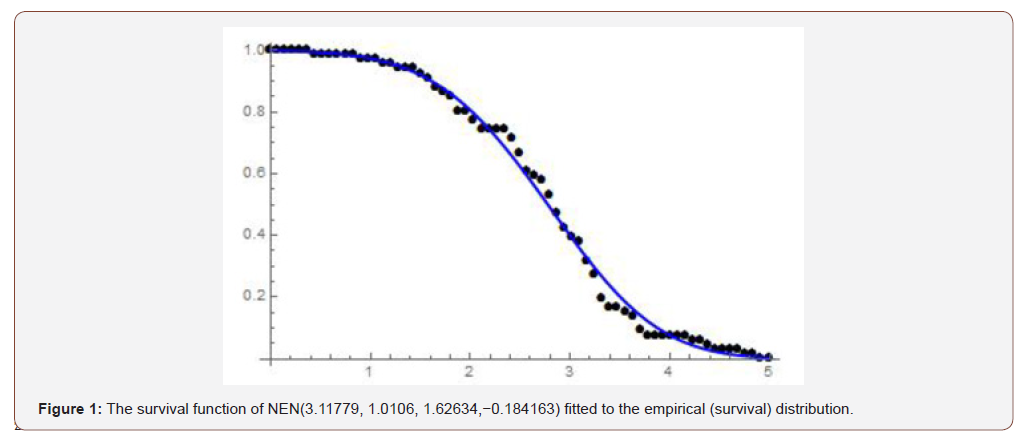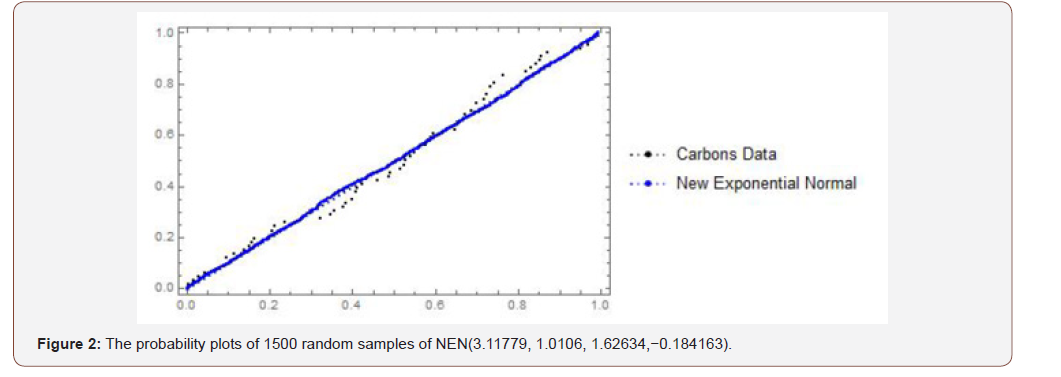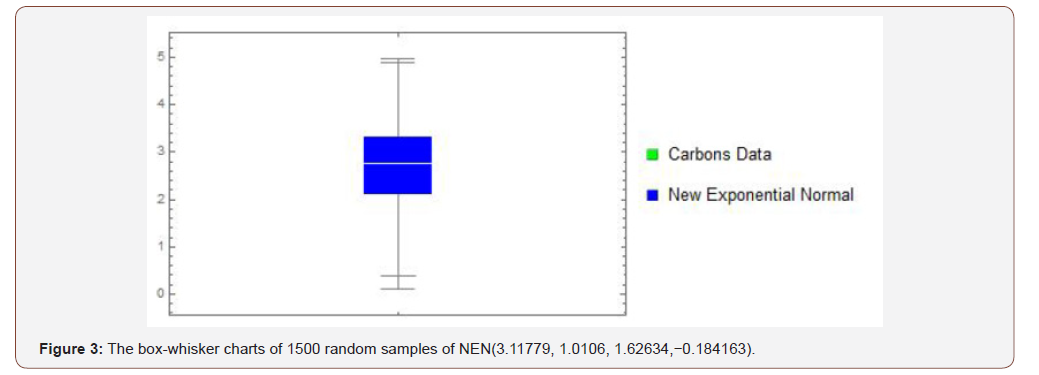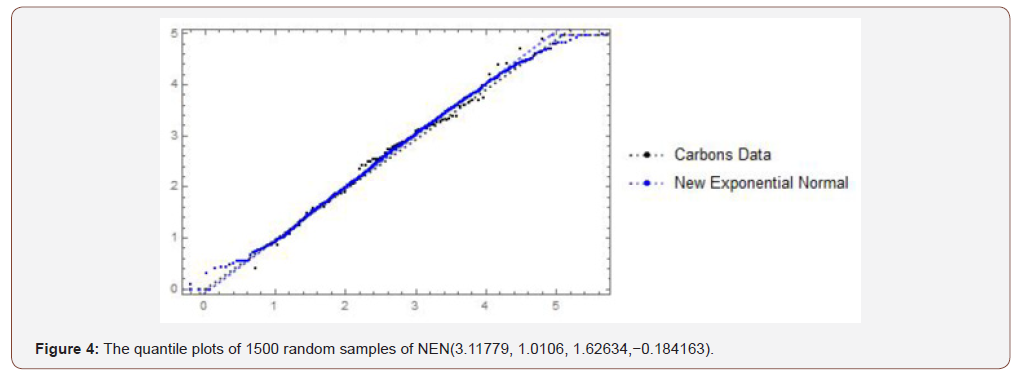 Mini Review
Mini Review
A New T-X Family of Distributions
Clement Boateng Ampadu, Department of Biostatistics, USA.
Received Date: June 26, 2019; Published Date: August 26, 2019
Abstract
This paper introduces a new weight in the T – X (W ) framework, and shows a new family induced by this new weight is good in fitting real-life data.
Keywords: Exponential distribution; Normal distribution; T-X family of distributions
The T − X(W) Family of Distributions
This family of distributions is a generalization of the the betagenerated family of dis-tributions first proposed in [1] In particular, let r(t) be the PDF of the random variable T ∈ [a, b], −∞ ≤ a < b ≤ ∞, and let W (F (x)) be a monotonic and absolutely continu-ous function of the CDF F (x) of any random variable X. The CDF of a new family of distributions defined in [2] is given by

where R(·) is the CDF of the random variable T and a ≥ 0
Remark 3.1: The PDF of the T − X(W ) family of distributions is obtained by differentiating the CDF above
Remark 3.2. When we set W (x) := − log(1 − x), then we use the term “T-X ” to de-scribe all sub-classes of the T-X(W) family of distributions induced by the weight function W (x)= − log(1 − x). A description of different weight functions that are appropriate given the support of the random variable T is discussed in [2]
A plethora of results studying properties and application of the T-X(W) family of distri-butions have appeared in the literature, and the research papers, assuming open access, can be easily obtained on the web via common search engines, like Google, etc
PT-G Family of Distributions" class="head-link">The PT-G Family of Distributions
Definition 4.1: [3]  ξ > where α is the rate
scale parameter and ξ is a vector of parameters in the baseline
distribution all of whose entries are positive. A random variable Z is
said to follow the
ξ > where α is the rate
scale parameter and ξ is a vector of parameters in the baseline
distribution all of whose entries are positive. A random variable Z is
said to follow the  power transform family of power transform
family of distributions if the Cumulative Distribution Function
(CDF) is given by
power transform family of power transform
family of distributions if the Cumulative Distribution Function
(CDF) is given by

Where  is the baseline
cumulative distribution with probability density function g(x; ξ).
is the baseline
cumulative distribution with probability density function g(x; ξ).
The New Weight and the Distribution
By modifying the parameter space for α in the  PT-Standard
Uniform family and using it in Remark 1.2, we define the new
weight as
PT-Standard
Uniform family and using it in Remark 1.2, we define the new
weight as

where  [0,1] . Using this we introduce
the following
[0,1] . Using this we introduce
the following
Definition 5.1: Let X be a random variable with CDF F (x; ξ) and PDF f(x; ξ); and let T be a random variable with support [0, ∞) whose PDF is r(t; γ), and whose CDF is R(t; γ); let ξ and γ be vector of parameters in the distribution of the random variables X and T, Citation: Clement Boateng Ampadu. A New T-X Family of Distributions. Annal Biostat & Biomed Appli. 3(1): 2019. ABBA.MS.ID.000553. DOI: 10.33552/ABBA.2019.03.000553. Page 2 of 3 respectively. The new T −X family distributions has CDF defined by the following

where 
Remark 5.2: The PDF of the new T-X family of distributions can be obtained by differentiating the CDF above
Practical Illustration
Assume X is a normal random variable with CDF

Where 

where t, b > 0 . Now the following is immediate from Definition 3.1
Proposition 6.1: The CDF of the new Exponential-Normal family of distributions is given by

where  and erfc
and erfc 
Remark 6.2: If a random variable M has CDF given by the previous Proposition we write M ∼ N EN (c, d, b, α) (Figure 1 & 2) [4]
The fit in Figure 1 and the approximately straight line in Figure 2 indicates the NEN distribution is a good fit.


By differentiating the CDF, we have the following
Proposition 6.3: The PDF of the new Exponential-Normal family of distributions is given by
where



As the box-whisker charts in Figure 3 and the quantile plots in Figure 4 appear almost identical, we have more evidence that the NEN distribution is a good fit.
Concluding Remarks
This paper has introduced a new T-X family of distributions via Definition 3.1 and has shown a member of this new class of distribtutions is a good fit to real life data. Our hope is that the researchers of distribution theory and its applications will further develop the properties and applications of the new T-X class of distributions.
Acknowledgement
None.
Conflict of Interest
No conflict of interest.
References
- Eugene N, Lee C, Famoye F (2002) The beta-normal distribution and its applications. Communications in Statistics-Theory and Methods 31(4): 497-512.
- Alzaatreh A, Lee C, Famoye F (2013b) A new method for generating families of continuous distributions. Metron 71(1): 63-79.
- Abdulzeid Yen Anafo (2019) The New Alpha Power Transform: Properties and Ap-plications, Master of Science in Mathematical Sciences Essay, African Institute for Mathematical Sciences (Ghana). Unpublished Manuscript.
- Ayman Alzaatreh, Carl Lee Felix Famoye (2014) T-normal family of distributions: a new approach to generalize the normal distribution, Journal of Statistical Distributions and Applications 1:16.
-
Clement Boateng Ampadu. A New T-X Family of Distributions. Annal Biostat & Biomed Appli. 3(1): 2019. ABBA.MS.ID.000553.
Exponential distribution; Normal distribution; T-X family of distributions
-

This work is licensed under a Creative Commons Attribution-NonCommercial 4.0 International License.






